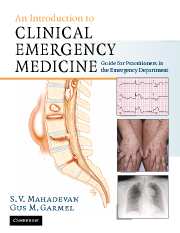Book contents
- Frontmatter
- Contents
- List of contributors
- Foreword
- Acknowledgments
- Dedication
- Section 1 Principles of Emergency Medicine
- Section 2 Primary Complaints
- 9 Abdominal pain
- 10 Abnormal behavior
- 11 Allergic reactions and anaphylactic syndromes
- 12 Altered mental status
- 13 Chest pain
- 14 Constipation
- 15 Crying and irritability
- 16 Diabetes-related emergencies
- 17 Diarrhea
- 18 Dizziness and vertigo
- 19 Ear pain, nosebleed and throat pain (ENT)
- 20 Extremity trauma
- 21 Eye pain, redness and visual loss
- 22 Fever in adults
- 23 Fever in children
- 24 Gastrointestinal bleeding
- 25 Headache
- 26 Hypertensive urgencies and emergencies
- 27 Joint pain
- 28 Low back pain
- 29 Pelvic pain
- 30 Rash
- 31 Scrotal pain
- 32 Seizures
- 33 Shortness of breath in adults
- 34 Shortness of breath in children
- 35 Syncope
- 36 Toxicologic emergencies
- 37 Urinary-related complaints
- 38 Vaginal bleeding
- 39 Vomiting
- 40 Weakness
- Section 3 Unique Issues in Emergency Medicine
- Section 4 Appendices
- Index
21 - Eye pain, redness and visual loss
Published online by Cambridge University Press: 27 October 2009
- Frontmatter
- Contents
- List of contributors
- Foreword
- Acknowledgments
- Dedication
- Section 1 Principles of Emergency Medicine
- Section 2 Primary Complaints
- 9 Abdominal pain
- 10 Abnormal behavior
- 11 Allergic reactions and anaphylactic syndromes
- 12 Altered mental status
- 13 Chest pain
- 14 Constipation
- 15 Crying and irritability
- 16 Diabetes-related emergencies
- 17 Diarrhea
- 18 Dizziness and vertigo
- 19 Ear pain, nosebleed and throat pain (ENT)
- 20 Extremity trauma
- 21 Eye pain, redness and visual loss
- 22 Fever in adults
- 23 Fever in children
- 24 Gastrointestinal bleeding
- 25 Headache
- 26 Hypertensive urgencies and emergencies
- 27 Joint pain
- 28 Low back pain
- 29 Pelvic pain
- 30 Rash
- 31 Scrotal pain
- 32 Seizures
- 33 Shortness of breath in adults
- 34 Shortness of breath in children
- 35 Syncope
- 36 Toxicologic emergencies
- 37 Urinary-related complaints
- 38 Vaginal bleeding
- 39 Vomiting
- 40 Weakness
- Section 3 Unique Issues in Emergency Medicine
- Section 4 Appendices
- Index
Summary
Scope of the problem
Eye complaints are very frequent in the emergency department (ED), although the actual number of visits per year is not known. Patients may complain of redness, swelling, pain, foreign body sensation, flashing lights, floating spots, visual field defects, blurred and/or decreased vision. The diagnoses may be common and benign, such as allergic conjunctivitis, or uncommon and vision-threatening, such as acute angle closure glaucoma (AACG), corneal ulcers, or central retinal artery occlusion (CRAO). Careful attention to the history and physical examination helps delineate the problem and define the treatment.
Anatomic essentials
The bony structure of the orbit is formed by a confluence of the frontal, maxillary, and zygomatic bones. The walls of the orbit are referred to by their anatomic location: superior, inferior, medial, and lateral. The inferior orbital wall or plate is quite thin and often fractured following a direct blow to the globe or orbit. The eyelids, the lacrimal gland (tucked away under the upper lid), and the canalicular system that drains tears into the nasal cavity make up the adnexal structures of the eye (Figure 21.1).
The globe (Figure 21.2) is divided into two sections: the anterior and the posterior segment. The anterior segment includes the cornea, limbal conjunctiva, iris, anterior chamber, and the lens. The conjunctiva is a thin, transparent mucus membrane that covers the sclera (bulbar conjunctiva) and the inner surface of the eyelids (palpebral conjunctiva).
- Type
- Chapter
- Information
- An Introduction to Clinical Emergency MedicineGuide for Practitioners in the Emergency Department, pp. 313 - 332Publisher: Cambridge University PressPrint publication year: 2005



